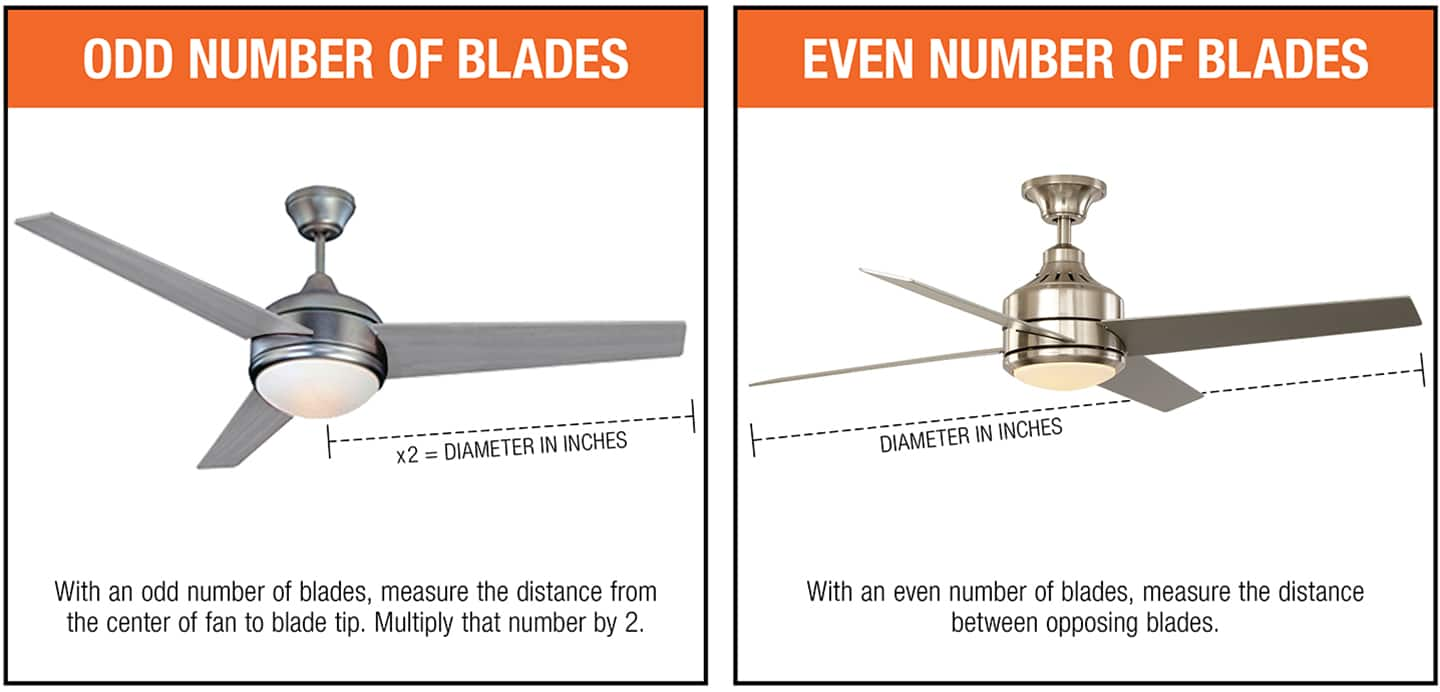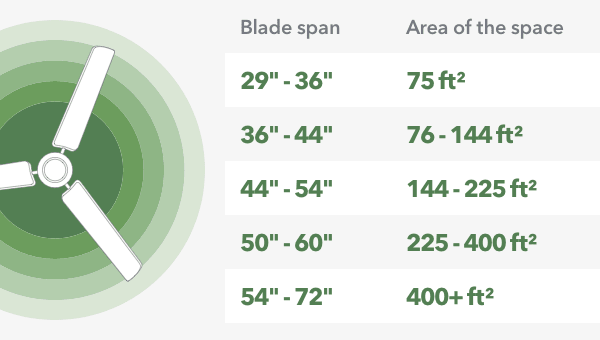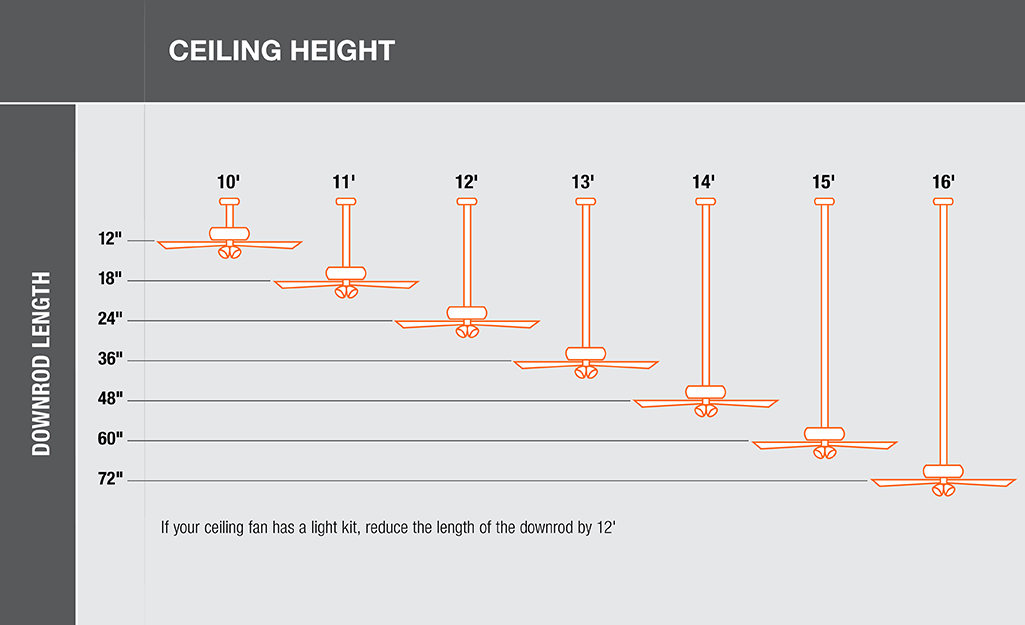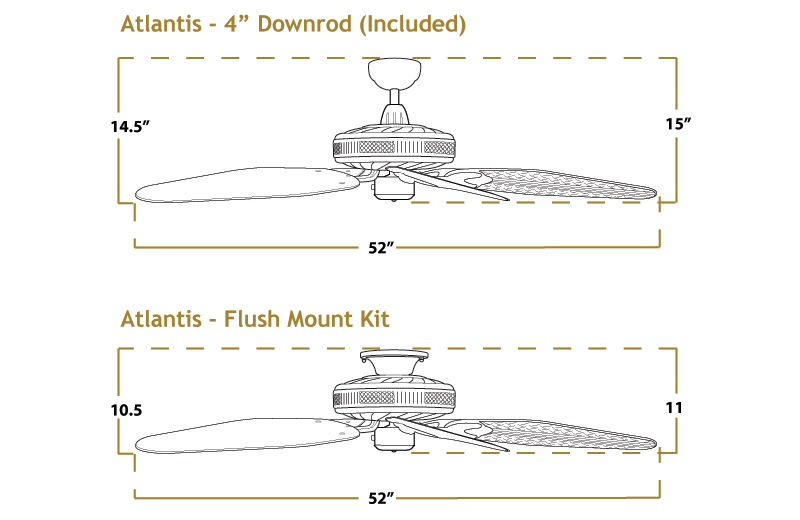The Right Way to Measure Ceiling Fan Size

When it comes to choosing a ceiling fan, one of the most crucial aspects to consider is its size. A ceiling fan that is the correct size for your space can make a significant difference in terms of airflow, comfort, and energy efficiency. However, determining the right ceiling fan size can be a bit of a challenge, as it involves various factors and considerations. In this comprehensive guide, we will delve into the art of measuring ceiling fan size, offering expert insights and practical tips to ensure you make the right choice for your home.
Understanding Ceiling Fan Size

The size of a ceiling fan refers to its blade span, which is the diameter of the circle formed by the fan's blades when they are fully extended. It is typically measured in inches and is a critical factor in determining the fan's coverage area and airflow. Choosing the appropriate ceiling fan size is essential to ensure optimal performance and avoid common issues such as inadequate cooling, excessive noise, or even safety hazards.
Factors Influencing Ceiling Fan Size Selection
Several key factors come into play when determining the right ceiling fan size for your space. These factors include the room's dimensions, ceiling height, and the intended purpose of the fan. Let's explore each of these factors in detail:
- Room Size and Shape: The size and shape of your room play a vital role in selecting the appropriate ceiling fan size. Generally, larger rooms require fans with a greater blade span to cover a wider area effectively. For instance, a spacious living room may benefit from a ceiling fan with a blade span of 52 inches or more, while a smaller bedroom may be suited for a fan with a blade span of 42 inches.
- Ceiling Height: The height of your ceiling is another critical consideration. Ceiling fans should be installed at a safe distance from the floor to ensure proper airflow and avoid any potential hazards. The recommended distance varies depending on the fan's size and the ceiling height. For standard 8-foot ceilings, a minimum clearance of 7 feet between the floor and the fan's blades is generally recommended.
- Purpose and Functionality: Understanding the primary purpose of your ceiling fan can help guide your size selection. For example, if you primarily use the fan for cooling and ventilation, a larger blade span may be preferable to maximize airflow. On the other hand, if you are installing a ceiling fan for aesthetic purposes or in a smaller space, a smaller blade span might be more suitable.
Measuring Ceiling Fan Size: A Step-by-Step Guide

Now that we have covered the key factors influencing ceiling fan size selection, let's dive into a detailed step-by-step guide on how to measure ceiling fan size accurately.
Step 1: Assess Your Room Dimensions
Begin by evaluating the dimensions of the room where you plan to install the ceiling fan. Measure the length and width of the room to determine its square footage. This information will help you understand the coverage area required and guide your fan size selection.
| Room Type | Recommended Blade Span |
|---|---|
| Small Rooms (up to 100 sq. ft.) | 36-42 inches |
| Medium Rooms (100-200 sq. ft.) | 44-52 inches |
| Large Rooms (200+ sq. ft.) | 52+ inches |

Keep in mind that these are general guidelines, and the actual blade span required may vary based on your specific room layout and ceiling height.
Step 2: Consider Ceiling Height and Clearance
Assess the height of your ceiling and determine the required clearance for the ceiling fan. As mentioned earlier, it is crucial to maintain a safe distance between the fan's blades and the floor to prevent accidents and ensure proper airflow. Refer to the manufacturer's guidelines or consult a professional for the recommended clearance based on the fan's size.
Step 3: Determine the Purpose and Functionality
Consider the primary purpose of your ceiling fan. Are you primarily using it for cooling and ventilation, or do you want it to serve as a decorative element in your space? Understanding your goals will help you choose the right blade span and design to meet your needs.
Step 4: Select the Appropriate Blade Span
Based on your room dimensions, ceiling height, and intended purpose, select a ceiling fan with the appropriate blade span. Remember that larger blade spans cover more area and provide stronger airflow, while smaller blade spans are more suitable for compact spaces or decorative purposes.
| Blade Span | Coverage Area | Airflow |
|---|---|---|
| 36-42 inches | Up to 100 sq. ft. | Moderate |
| 44-52 inches | 100-200 sq. ft. | Strong |
| 52+ inches | 200+ sq. ft. | Powerful |
Step 5: Explore Additional Features and Specifications
Once you have determined the appropriate blade span, explore other features and specifications that align with your preferences and requirements. Consider factors such as energy efficiency, blade design, noise levels, and additional functions like lighting or remote control.
The Impact of Ceiling Fan Size on Performance
Choosing the right ceiling fan size has a significant impact on its performance and overall effectiveness. Here's a closer look at how ceiling fan size influences various aspects of performance:
Airflow and Cooling
Ceiling fan size directly affects the amount of air it can move and the resulting airflow. Larger blade spans provide more surface area for air movement, resulting in stronger and more widespread airflow. This can be particularly beneficial in larger rooms or during hot summer months when optimal cooling is essential.
Energy Efficiency
Ceiling fans are known for their energy efficiency, and choosing the right size can further enhance this aspect. A well-sized ceiling fan can effectively cool a room without overworking itself or consuming excessive energy. By selecting a fan with an appropriate blade span, you can ensure efficient and cost-effective cooling, reducing your energy bills and environmental impact.
Noise Levels
Ceiling fan size can also impact the noise levels produced by the fan. Larger blade spans generally result in a quieter operation, as the air movement is distributed over a larger area. On the other hand, smaller blade spans may produce more noticeable noise, especially at higher speeds. Considering the noise levels and selecting a fan with appropriate noise-reducing features can ensure a comfortable and peaceful environment.
Comparative Analysis: Different Ceiling Fan Sizes
To provide a clearer understanding of the impact of ceiling fan size, let's compare three different fan sizes and their performance characteristics:
Ceiling Fan Size: 36-42 inches
Ceiling fans with a blade span of 36-42 inches are well-suited for small to medium-sized rooms. They offer moderate airflow and are ideal for spaces up to 100 square feet. These fans are often more affordable and compact, making them a popular choice for bedrooms, offices, and smaller living areas. While they may not provide the strongest airflow, they are efficient and can effectively cool the immediate area.
Ceiling Fan Size: 44-52 inches
Ceiling fans with a blade span of 44-52 inches are designed for medium to large rooms. They offer stronger airflow and are capable of covering areas up to 200 square feet. These fans are a popular choice for living rooms, dining areas, and master bedrooms. With their increased blade span, they provide a more powerful cooling effect, making them ideal for spaces that require more substantial airflow.
Ceiling Fan Size: 52+ inches
Ceiling fans with a blade span of 52 inches or more are reserved for large and expansive spaces. They are designed to provide powerful airflow and are suitable for rooms exceeding 200 square feet. These fans are often found in open-plan living areas, great rooms, or large commercial spaces. With their extensive blade span, they can efficiently cool and circulate air throughout the entire space, ensuring optimal comfort.
Future Implications and Considerations

As technology advances and energy efficiency becomes a growing concern, the future of ceiling fans holds exciting possibilities. Here are some considerations and potential developments to keep in mind:
- Smart Ceiling Fans: The integration of smart technology into ceiling fans is already underway. Smart fans offer advanced features such as voice control, app connectivity, and energy monitoring. These fans can adapt their performance based on real-time data and user preferences, optimizing energy efficiency and comfort.
- Energy-Efficient Designs: Manufacturers are continuously improving the energy efficiency of ceiling fans. Expect to see fans with innovative blade designs, advanced motor technologies, and improved aerodynamics, resulting in even more efficient and sustainable cooling solutions.
- Personalized Cooling Experiences: With the advancement of technology, ceiling fans may offer personalized cooling experiences. Through advanced sensors and algorithms, fans could adjust their performance based on individual preferences, room occupancy, and environmental factors, providing a customized cooling experience tailored to each user.
Frequently Asked Questions (FAQ)
Can I use a ceiling fan with a smaller blade span in a larger room?
+Using a ceiling fan with a smaller blade span in a larger room may result in inadequate airflow and cooling. It is recommended to choose a fan with a blade span suitable for the room's size to ensure optimal performance.
Are larger ceiling fans more expensive than smaller ones?
+In general, larger ceiling fans tend to have a higher price tag due to their increased size, materials, and performance capabilities. However, it is essential to consider the long-term benefits and energy efficiency when making a decision.
Can I install a ceiling fan with a large blade span in a room with a low ceiling?
+Installing a ceiling fan with a large blade span in a room with a low ceiling may not be practical or safe. It is crucial to maintain the recommended clearance between the fan's blades and the floor to ensure proper airflow and avoid any potential hazards.
Are there any ceiling fan size recommendations for specific room types?
+Yes, there are general recommendations for ceiling fan sizes based on room types. For instance, a bedroom or office may require a smaller blade span (36-42 inches), while a living room or dining area may benefit from a larger blade span (44-52 inches). However, it's essential to consider the specific dimensions and ceiling height of each room.
Can I use multiple ceiling fans in a large room instead of a single larger fan?
+Using multiple smaller ceiling fans in a large room can be an effective solution to achieve optimal airflow and coverage. However, it is crucial to consider the total combined wattage and ensure the electrical system can handle the load. Additionally, proper placement and spacing of the fans are essential for effective cooling.
By following this comprehensive guide and considering the various factors, you can confidently choose the right ceiling fan size for your space. Remember, selecting the appropriate ceiling fan size not only ensures efficient cooling and comfort but also contributes to energy savings and a more sustainable home environment.



